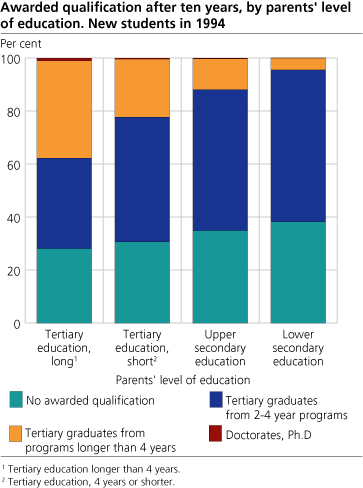Content
Published:
This is an archived release.
Rise in tertiary degree completion
Compared with students who began their tertiary studies in 1984, a higher proportion of newly registered tertiary students in 1994 completed a tertiary degree within 10 years,
Among the 37 400 students who began their tertiary education in 1994, 66 per cent had completed a degree within ten years - a small increase from 63 per cent of students who began their tertiary studies in 1984. Around 10 per cent more women than men who enrolled for the first time in 1994 completed a tertiary degree within ten years.
Parents' education counts
Among students who began in 1994, the proportion with no awarded qualification after ten years increases as parents' level of education decreases. Of students whose parent(s) had little or no formal education, 38 per cent had not completed any degree ten years after they entered the tertiary education system. An equivalent proportion of students whose parent(s) had achieved postgraduate education also attained a postgraduate level of education within ten years. In contrast, just 4 per cent of students whose parents had no more than compulsory education had completed postgraduate studies by 2004.
When counting undergraduate degrees, which can be taken at all types of tertiary institutions in Norway, almost double the proportion of graduates from private university colleges in 2004/2005 completed their degrees within the expected timeframe, compared with graduates from universities and specialized university institutions. It should be noted that throughput statistics are defined as the number of years since first time registration in tertiary education, and are not readjusted if a student changes to a new degree. According to this definition, very few students who switch degrees underway will be able finish within the expected timeframe. Deferment and part-time studying are not accounted for either.
Master students in philosophy and science graduate fast
Among graduates in 2004/2005 from the new five-year Master programmes, as many as 87 and 78 per cent of those who were awarded Master of Philosophy and Master of Science degrees, respectively, finished within five years of first registration in tertiary education in Norway. Pharmacy graduates were fastest among six-year programmes through the education system. 48 per cent completed their degree within six years, while an additional 20 per cent finished after seven years in tertiary education.
High throughput of engineering and nursing students
The highest proportion of graduates from three-year programmes who completed within the normal timeframe can be found among Engineering and Nursing degrees and Bachelor degrees in health, welfare and sport. Around one in two of these graduates completed their degree within three years of registration in tertiary education. Some fields of study have a large gender variation, the most apparent being in Bachelor degrees in primary industries, where 52 per cent of male graduates completed on time, compared with 26 per cent of females.
|
As part of the Quality Reform in 2003, undergraduate degrees were reduced from four to three year programmes, and postgraduate degrees from six to five years. One aim of the reform is to align Norwegian tertiary education with international Bachelor and Master degree programmes. Throughput statistics will be affected during the transition from old to new degree structures, as students may have started a four or six year degree and changed to a Bachelor or Masters degree underway. |
Tables:
- Table 1 Undergraduate courses, by number of graduates in 2004 since the student was first registered in tertiary education. Absolute figures and per cent
- Table 2 Postgraduate courses, by number of graduates in 2004 since the student was first registered in tertiary education. Absolute figures and per cent
- Table 3 New entrants to tertiary education in 1984 and 1994, by gender and awarded qualification after ten years. Absolute figures and per cent
- Table 4 New entrants to tertiary education in 1984 and 1994, by parents' level of education and awarded qualification after 10 years. Absolute figures and per cent
- Table 5 Completion of selected undergraduate courses in 2004. Absolute figures and per cent
Contact
-
Jane Bekkengen
E-mail: jane.hansine.bekkengen@ssb.no
tel.: (+47) 40 81 13 52
-
Geir Nygård
E-mail: geir.nygard@ssb.no
tel.: (+47) 48 15 13 44
-
Nawid Fazli
E-mail: nawid.fazli@ssb.no
tel.: (+47) 97 09 77 18

